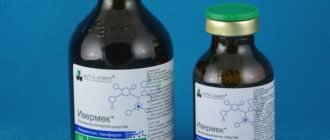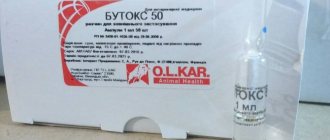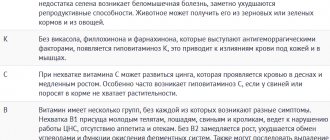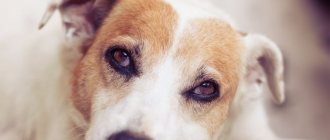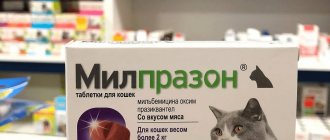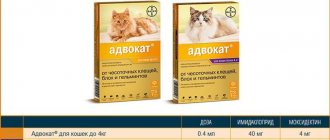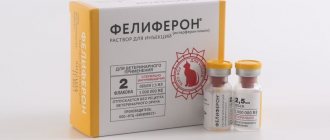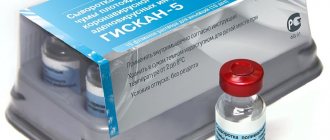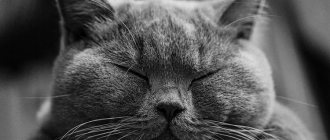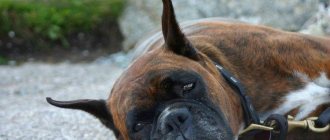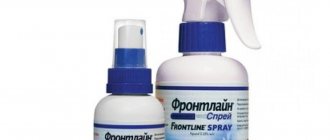Butox is an insecticidal and acaricidal drug that has proven itself in veterinary medicine, according to numerous reviews, as the best. In a nutshell, solutions based on this substance are perfect for getting rid of parasites that cause inconvenience not only to animals, but also to people. The product copes with its task better than analogues (neocidol, ectosan). In addition, Butox is relatively inexpensive. You will find out more details in the provided article below.
Active ingredient and principle of action
Deltamethrin is used as the main active ingredient of Butox.
This is a highly effective insecticide from the pyrethroid group used in agriculture. Like most isomers of this group, the action of deltamethrin is based on the activity of chrysanthemum acid, the free radicals in the formula are bromine atoms. In its technical form, deltamethrin is insoluble in water, so in the household it is used in ready-made form in Butox ampoules of 1 ml, the contents of which are diluted in 3-4 liters of water and used for treating premises and animals. Method of penetration and absorption - contact and intestinal pesticide. Butox is used only for external use; recommended doses do not cause allergies. The substance is widely used in the agricultural sector, in households and in medicine to combat a number of parasites, harmful and synanthropic insect species. The deltamethrin formula contains only 1 isomer, which has a strong insecticidal effect. To create the drug, the one that has the most powerful insecticidal effect of the 8 existing isomers was chosen.
All pyrethroids have a destructive effect on the insect’s nervous system, disrupting calcium metabolism in synapses, and act on potassium-sodium channels, disrupting acetylcholine metabolism. As a result of strong stimulation of the nervous system, exoparasites die, and the protective effect of the active substance lasts about 15 days.
Analogue preparations of deltamethrin contained in Butox include butoflin, splender, decamethrin and others. The preparations are used for spraying agricultural crops and controlling pests. For warm-blooded representatives of the animal world, including humans, deltamethrin and Butox are moderately toxic substances. It is not used near apiaries; residues are not poured into open ground near water bodies due to the high toxicity of the isomers to fish.
Reviews about the drug from breeders
Dog owners note that Butox really protects their pets from parasites.
Irina, Khabarovsk. A dog appeared in our apartment recently, but we met Butox much earlier. Our apartment is on the first floor, so our guests every year were ants and all sorts of bugs that appear from dampness. Someone recommended Butox, which helped us quickly get rid of these parasites. And when we got an Alabai, we didn’t even think about how to get fleas out of him. The only inconvenient moment for us was that we had to completely bathe our pet and then wrap him up so that he would not lick his lips. Gradually, the Admiral got used to bathing and dressing, so we started using Butox as a preventive measure against ticks.
Marina, Suvorov. Butox was recommended to us by friends. There are quite a few pets living in our house, so the choice was precisely inexpensive products. Having purchased Butox, we treated all our cats and dogs with it, but were unpleasantly surprised by the smell. The unpleasant aroma seemed to permeate the animals through and through. But this was our first meeting with this product. When we resorted to using it again, we, strangely, did not smell it. It turned out that this was a matter of habit. For the second year now, Butox has always been on the shelf in our country house. Even though our animals are treated, they run around the street and “catch” parasites from other yard animals. The instructions say that the protective effect of the drug lasts up to 15 days. I can confidently confirm this from my own experience. Our Busyas and Basyas have enough protection for almost a month. Only after this period has expired do we have to carry out processing again.
Butox instructions for use
Butox instructions for use are well-tested recommendations that allow you to achieve the desired treatment effect. Butox 50 in the form of a single dose dissolved in water is used entirely on one animal, spraying it onto the fur from a spray bottle and avoiding the eye area.
The animal's face is carefully smeared with a cotton swab. After this, it is recommended to let the pet dry and put on a protective cover to avoid licking off the Butox for 3 days. After treatment, the product is not washed off; its effective effect lasts for at least 15 days.
After this period, in case of severe mite infestation, it is recommended to repeat the treatment. If certain areas of the body are severely affected, they are first lubricated with a generous amount of Butoks aqueous solution, and then the pet’s fur is generously sprayed.
When carrying out the procedure outdoors, be careful not to spray against the wind. In case of contact with skin, it is recommended to wash off the product with soap. Please note that Butox has a strong and unpleasant odor.
General recommendations
Butox50 is a highly effective means of combating exoparasites and in some cases can have a sanitizing effect on a number of pathogens due to its pesticide action. When purchasing Butox 50 in ampoules, the instructions for it contain a detailed description of the procedure for treating your pet. It's not difficult, but it does require some precautions.
The key feature of Butox is its low price; as a rule, you can buy the product in veterinary pharmacies in the form of one ampoule. Its cost is significantly lower than other “pipette” drugs that are used for treatment, and its effectiveness is much higher.
Also for Butox 50, the instructions for use contain information on the treatment of tick-borne infestations in animals. Moreover, treating your pet will cost a minimal amount, the effectiveness will be very high, and the toxicity will be low.
Despite the fact that few pet owners know about this quality of Butox, it is a highly effective drug for a number of diseases. It is distinguished by low toxicity, price and high efficiency in the fight against a number of parasitoses in animals.
In some cases, subject to safety rules, it can be used to treat a person under the supervision of a doctor. For example, for complex scabies, mites infestation of the scalp. Treatment is carried out once every 7-10 days, without violating the dosage.
Purpose
According to the instructions, Butox is used to destroy crawling and flying arthropods on animals, walks, pastures, and in premises including housing. The drug has a protective effect. You should not bathe the animal three days before and the same time after treatment.
Butox 50, like other pesticides, does not affect arthropod eggs, so you need to wait three days until the larvae hatch. In order for them to become poisoned, it is important not to dilute the pesticide. It is believed that the toxicity of pyrethroids for warm-blooded animals is 2000 times less than for cold-blooded animals. But this is in case of contact with skin. Therefore, when working with Butox and analogues, it is necessary to protect your eyes, nostrils, and mouth.
Butox 50 for chickens - a veterinary drug for the destruction of ectoparasites of birds and the treatment of chicken coops
Active substance: synthetic pyrethroid deltamethrin (deltamethrin).
An insecticidal-acaricidal 5% solution of the drug Butox 50 is used to destroy scabies, ixodid and chicken mites, lice, fleas, lice, bedbugs, flies, midges and other ectoparasites . Active against adults and larvae, but does not affect insect eggs.
Fights against pests that are immune to preparations containing phosphorus and organochlorine compounds. Toxic to fish and bees.
Once in the body of parasitic insects, the pyrethroid deltamethrin accumulates on the periphery of their nervous system, suppresses nerve impulses, depriving the insects of mobility and causing paralysis and death.
If it comes into contact with the skin of warm-blooded animals and humans, it can be toxic in concentrated form . When diluted, it has virtually no irritating and/or allergic effect.
Composition and release form
The main component of the product is deltamethrin, which belongs to the group of pyrethroids of synthetic origin. It has long been known that pyrethrum can repel various insects.
It is very convenient that the drug can be bought in the quantity you need
The active component does not dissolve in water, as it is similar to wax. An auxiliary component is an organic eluent. The drug is often called Butox 50, because it is a 5% deltamethrin solution. The insecticide is an oily liquid with an unpleasant odor of kerosene, which forms a whitish emulsion. The product can be produced in different packages, starting from 1 ml glass ampoules and ending with 1 liter metal containers.
Pharmacology of the drug
Pyrethroids can come into contact with skin lipids. In this case, the solvent and water evaporate, and waxy substances join the fats. For all warm-blooded organisms, pyrethroids are practically non-toxic, since they remain on the surface and are not absorbed.
At the next stage of protection, the active substance is destroyed into harmless compounds . In cold-blooded organisms, the body does not have protective functions, so when the pyrethroid ends up on the insect's body or in its intestines, it deactivates acetylcholine. As a result, the arthropod experiences paralysis, after which it quickly dies.
The instructions for using Butox in veterinary medicine warn: when working with the drug, you need to be extremely careful . If the drug gets into the soil near the river, the fish will die, if it gets on a honey plant, the bees will die.
Video instructions about the qualities of this drug:
Precautionary measures
According to the instructions for use of Butoxcept 5 ml, this drug is moderately toxic for humans.
When working with it, you need to be careful, protecting your skin and face from the emulsion.
To do this, you should wear goggles, gloves, special clothing and a respirator. If the concentrate gets on your skin, you should immediately remove it with a stream of water. And before starting work, it is recommended to drink 7-10 tablets of activated carbon.
Butox 1 ml cannot be used on mammals that are under one year old or sick. It is also prohibited to combine Butox with organophosphate drugs. It is better to process cows during dry periods or give their milk to animals.
The drug should be stored in non-residential premises where there is no heating, since Butox contains a solvent that evaporates. The shelf life of the drug is 4 years at a storage temperature of -15...+40°C.
It is not recommended to consume milk from cows that have recently been processed
Pharmacology
Pyrethroids are able to interact with lipids of the skin, as well as plant leaves. The water and organic solvent evaporate and the waxy substance adheres to the fats. For warm-blooded creatures, pyrethroids are low-toxic because they are almost not absorbed, remaining on the surface of the skin. The second defense mechanism is the rapid destruction of the active substance to harmless compounds. Cold-blooded animals do not have defensive devices, so the pyrethroid, when it gets onto the surface of the body or into the intestines of the insect, deactivates acetylcholine. The functioning of the nervous system is disrupted, paralysis occurs, and the arthropod dies. When working with Butox 50 and other drugs containing pyrethroids, caution is required. Drops that fall on a flower plant will kill the bees, and if the drug spills on the soil and is then washed away by rain into the river, the fish will die.
Application
An aqueous emulsion of Butox 50 is prepared on the day of use according to the instructions for carrying out the following insecticidal measures:
- Bathing.
- Spraying.
- Wetting.
- Treatment of premises.
- Processing of paddocks.
Sheep bathing
They practice bathing sheep. Before mass events, the drug is tested on a small group of animals. Lambs of different ages and different fatness are selected and observed for 2–3 days.
Swimming is carried out in warm, but not hot weather. To do this, use a specially prepared cupping pit located on a hill far from bodies of water. The need for Butox is calculated based on the volume of water and the required 0.05% concentration. To ensure access of the medication to the skin, treatment is carried out after cutting the hair.
Cupping pit
Animals do not need to be fed before bathing, but they should be given water. To ensure uniform distribution of the active substance, the solution is mechanically stirred for 20 minutes. Then 20 sheep are driven through the bath, removing a tenth of the working solution. Its amount is restored by adding 1.5 liters of Butox per 1 m3 of water. To allow the insecticide to drain off, the sheep are kept in a specially prepared pen. The waste liquid, as well as dirt from the pit, and water after washing it are transferred to settling wells. Make sure that the working solution does not get into the reservoir. At the discretion of the veterinarian, sheep bathing can be repeated within 10 days.
Chickens bathing
If chickens lose feathers, they are examined for lice eaters. If parasites are found, the easiest way to get rid of them on the bird is by bathing. The treatment is carried out in warm, but not hot weather. Add 0.9–1 liter of Butox to 1 m3 of water. Chickens are thrown into a container with a working solution in small groups of 10–20 individuals. If there are few birds, a bucket or basin will do. The chickens must dry out.
Chicken being bathed
Spraying
Before treatment, ensure uniform mixing of Butox with water inside the sprayer. If an animal is diagnosed with scabies, then it is necessary to use a 0.1% emulsion. For a large animal, reserve 3 liters of working solution. The treatment is carried out in the absence of strong wind. It is necessary to avoid contact of the emulsion with the eyes of animals and humans.
Spraying livestock
It is recommended to carry out processing in the following sequence:
- The inner, then the outer surface of the ears.
- Head.
- Torso.
- Anal area and tail.
- Legs.
Inflamed areas are treated with special care. This applies, first of all, to the treatment of sarcoptic mange in pigs. In order to destroy the larvae that have hatched from the eggs and prevent them from becoming sexually mature, it is necessary to repeat the treatment within 7–14 days.
Scabies
When keeping animals on pastures with an abundance of midges, treatments are carried out weekly. The drug is not washed off to maintain its protective effect. The instructions recommend different dosages to kill ticks, lice, and flying insects. Typically, the animal is attacked by all types of parasites, so the highest recommended dosage should be used. In pig farming, when lice are detected, a 0.025–0.033% emulsion is used.
If it is not possible to bathe the chickens, they are sprayed. 15–30 ml of working emulsion solution is used for each bird. In addition, the room needs to be treated.
Wetting
This technique is used to destroy ectoparasites on dogs and fur-bearing animals. If scabies is treated, then the lesions are treated. Long-haired animals are bathed. Typically, ampoule packaging is used. When treating against fleas or lice, one milliliter portion is dissolved with four liters of water.
Butox 50
To treat scabies, you will need a more concentrated emulsion - one serving per 1 liter. When treating against ixodid ticks, it is recommended to dilute the contents of the ampoule with 1.3 liters of solvent. Reliable protection against parasites is provided by weekly treatment of your pet's fur.
The situation is more complicated with cats. Their habit of licking themselves can lead to poisoning. It takes at least 2 hours for the working emulsion to dry and become harmless. At this time, the cat is put on an Elizabethan collar. Three days before disinfestation and for the same period after, the animal must not be bathed. The use of shampoos inactivates the drug.
Cat in Elizabethan collar
Premises treatment
Butox can be used for aerosol disinfestation of industrial and residential premises, pens, sheds, in the presence of animals. The dosage of the working emulsion and its consumption depend on the type of parasites and the nature of the surfaces. For 100 m2 of a flat surface, 5 liters of liquid are required, for the same area with a porous structure - twice as much. For crawling insects, use Butox in 0.3% concentration. For those flying, it is enough to dissolve 7.5 cm3 of insecticide in 5 liters of water.
Disinsection of premises
If the chicken coop is being treated, the floor is swept, dust is removed from the walls, the feeders are washed, and all surfaces are thoroughly sprayed. The longer the duration of the drug (ideally 3 days), the higher the effect. Before letting chickens into the room, it is well ventilated.
If there are dogs or cats in the apartment, then there must be fleas. They settle on carpets, rugs, furniture upholstery and from time to time attack pets and owners. Butox is well suited for treatment against fleas and other arthropods in the apartment. It does not leave stains on carpets and upholstered furniture. For treatment, 1.5 liters of solution containing 1 ml of concentrate is required.
Before treatment, animals and people are removed from the apartment, furniture is moved aside to make baseboards accessible, carpets are irrigated, rolled up, and floors are washed. The surfaces of pantries and cabinets, except the refrigerator, are treated with special care. They close the windows and doors and leave the apartment for several hours, or better yet, days. Before people and animals are allowed into the house, it is ventilated. If necessary, the treatment is repeated after 7–14 days.
Apartment processing
After disinfestation, it is not recommended to wash floors with water for a week. Pest eggs are insensitive to pesticides. But they hatch into larvae, which are intended to be destroyed by the plaque formed after washing the floors with an insecticide solution.
Treatment of chickens and premises
The drug can be used to kill chicken parasites in several ways:
- medicinal baths;
- spraying;
- room treatment.
To prepare a floating bath for swimming, 0.9 liters of the drug is needed per ton of cool tap water. The prepared solution is thoroughly mixed for ten minutes to obtain a more uniform emulsion. Next, the birds in small groups (10-20 birds) are driven through a container with an evenly distributed solution.
The bird should not be tired or hungry. In addition, it is necessary to give the chickens a drink first; to avoid ingesting the solution, which may be toxic, it is better to avoid getting the solution into the bird’s body.
When preparing a solution for spraying chickens, take 50-100 ml of the drug per 100 liters of water. The components of the solution mix well. Each feather of the bird is carefully sprayed with the prepared composition. The applied emulsion should dry; there is no need to rinse off the solution.
In addition to treating the poultry itself, it is also necessary to disinfect the premises in which the chickens are kept. The solution for treating premises consists of 15-30 ml of the drug per 10 liters of water. Before spraying, it is necessary to clear the room of food residues, sweep the floors, clean all boxes, feeders and perches. After this, the solution is evenly applied using a spray bottle to horizontal and vertical surfaces, floors, and walls. Since the active ingredient of the drug is moderately toxic, the premises should be left empty for several days. Chickens can only be returned to their original habitat after thorough ventilation.
If the poultry and the premises in which the chickens are kept are thoroughly treated, repeated spraying will not be necessary. The substance of the drug destroys the colony of parasites completely.
How can you recognize cloacitis in chickens and how to cure this disease? Find out about this by reading our article.
Why do roosters' combs turn black? All reasons are described here.
How to treat a room with Butox
This is especially true for old, wooden buildings. There are often bedbugs there. These insects can cause a lot of trouble, but in order for the insects to stop bothering you, you just need to purchase the drug “Butox”. The price for a package of 5 ampoules does not exceed 110 rubles, so you can treat a room of any size.
To kill bed bugs, the drug is diluted in one liter of water. The solution is poured into a spray bottle and the room is treated. It is necessary to go through mattresses and sofas, baseboards and cracks, floors and walls. After processing, an unpleasant odor remains, it resembles kerosene. Therefore, it is better to leave the premises for several days during the treatment period.
An apartment in which people and animals live can also be treated using Butox. It will not only get rid of lice and fleas, but will also provide effective assistance in the fight against any crawling and flying parasites. Butox 50 has proven itself well in the fight against flies, ants, bedbugs, cockroaches and many other unwanted neighbors.
The apartment is treated with a solution of the drug, which is taken in an amount per 10 liters of water:
- from flying insects – 15 ml;
- from crawling parasites – 30 ml.
If the surface of the floor or walls being treated has a smooth structure, 5 liters of solution per 100 square meters of area is sufficient. If the surface is porous, you will need twice as much solution.
Residential premises where pets and their owners live can also be treated with Butox. It will not only lead to the death of all fleas and lice, but can also provide excellent assistance in the fight against other flying and crawling insects.
We suggest you read: How to treat ear mites in cats
“Butox” in ampoules has shown itself to be excellent in the fight against ants, flies, cockroaches, bedbugs and many other harmful parasites. The living space is treated with the composition of the drug, which must be taken in an amount per 10 liters of water:
- from crawling insects – 35 ml;
- against flying parasites – 20 ml.
When the wall or floor structure being treated has a relatively smooth surface, then five liters of solution per 100 square meters is enough. m. room size. With a porous structure, you will need twice as much solution.
Signals of the appearance of pests in the body of a pet can be:
- fast fatiguability;
- weakened immune system;
- depression;
- drowsiness;
- spasms in internal organs and various pains.
Cautions
The instructions for Butox must be fully followed. Precautionary measures will enable you to avoid trouble while using the drug:
- the drug should not get into your pet’s eyes, mouth or nose;
- it is necessary to handle a pet only using gloves;
- It is prohibited to use this product simultaneously with organophosphate insecticides;
- The product is not used for weakened animals, with open wounds, or on damaged skin areas;
- when an animal exhibits high sensitivity to this drug, its use must be stopped immediately;
- After extensive treatment, the fur must be completely dry; at this time, it is necessary to protect the pet from licking the fur.
The main advantages of Butox:
- quite convenient and easy to use;
- affordable price for every pet owner;
- the ability to purchase the product at almost any veterinary pharmacy;
- the presence of a residual effect;
- absolute effectiveness when fighting parasites and insects on cats and dogs.
To summarize, the product in ampoules is one of the most affordable drugs for combating a variety of skin parasites for dogs and cats, which is most effective during a single treatment and can destroy the majority of pests.
The most important difference between Butox and many drugs for the same purpose is the need to dilute the product to make an emulsion, and not immediately drip it onto the skin. The emulsion is applied to the entire skin, and not at individual points.
Before treating apartments with Butox, remove children and pets from the premises, clean aquariums and plants, and avoid contact of the insecticide with food. Work with the substance in special protective equipment.
How to make a solution for treating premises:
- Dilute one ampoule with 2-4 liters of water.
- Pour the product into the respirator and treat the surfaces or use a rag or brush to apply the product.
- The floor is cleaned thoroughly.
- After treatment for a week, the product is not removed from surfaces to improve the effect.
- Subsequently, it is necessary to vacuum all treated areas, especially upholstered furniture, to remove dead individuals.
There is no need to add other insecticides to the solution. Fleas are found in the apartment in upholstered furniture and baseboards, cabinets and behind them. For them, favorable conditions for reproduction are in bulk products. Therefore, it is recommended to throw away all contaminated cereals, as they may contain eggs.
Cautions
The instructions for the drug must be followed completely. Precautionary measures will allow you to avoid troubles when using Butox:
- handle the animal only with gloves;
- the product should not get into the animal’s nose, mouth or eyes;
- After abundant wetting, the fur must dry completely, you need to protect your pet from licking the fur at this time;
- Butox cannot be used in combination with organophosphate insecticides;
- if an animal exhibits hypersensitivity to the drug, its use should be stopped immediately;
- The drug is not used on damaged areas of the skin, on open wounds, or on weakened animals.
“Butox-50” in ampoules: instructions for use, analogues
Reviews of this drug often receive praise. What causes this? Let's figure out what the features of this tool are and how to use it correctly. The antiparasitic agent “Butox-50” looks like an oily liquid of light yellow color, which has a specific odor, not very pronounced. For use at home, use “Butox-50” in ampoules, which allows you to correctly and without much effort prepare an active solution that is safe for others. For convenience, the ampoules are packed in cardboard boxes of five pieces.
“Butox-50,” the instructions for use of which are in the package, is used to kill fleas, lice, lice, chicken mites, scabies and ixodid mites, as well as flies, mosquitoes and bedbugs.
The working solution of the drug must be prepared immediately before use. To do this, the concentrated Butox-50 emulsion is diluted with cool tap water in proportions that depend on what parasites are to be fought:
- Lice, fleas, lice eaters – 1 ampoule (1 ml) per 4 liters of water. Repeated treatment is carried out after a month.
- Ixodid ticks – 1 dose per 1.5 liters of water. The second treatment should be carried out after 2 weeks, and after that - as necessary.
- Scabies mites – 1 ampoule per 1 liter. Not only the affected area should be treated, but also the area around it. After a week and a half, the event is repeated.
Calculate the required concentration of the drug using the general formula:
(A*B)/C=X, where A is the required concentration of the working solution; B – required amount of emulsion (ml); C – content of active substance in solution (%); X is the amount of concentrate (5%) required to prepare 1 liter of working fluid.
For example, you need to prepare a liter of solution with a concentration of 0.004%. The data is substituted into the formula and you get:
X= (0.004%*1000 ml) / 5%
X= 0.8 ml
This means that in order to prepare 1 liter of 0.004% solution, you need to take 0.8 ml of concentrate (5%); for 10 l – 8 ml of “Butox” (8 ampoules), which is diluted in a small amount of water and poured into the prepared container, then adjusted to the required volume.
Analogues of “Butox-50” are the following drugs:
- “Neocidol”;
- “Neostomazan”;
- “Sebacil 50%”;
- "Ektosan";
- “Biofly”;
- "Deltalan-50".
Treatment of poultry housing areas
To get rid of blood-sucking parasites, it is extremely important to clean and disinfect the premises where birds are kept . You only need to work in protective clothing, paying special attention to respiratory protection.
The number of birds is removed from the chicken coop. Before processing, clean all feeders, boxes, perches, partitions and cages. The remaining food and bedding are taken out and burned, and the floor is swept.
The solution is mixed at the rate of 15-30 ml of Butox 50 per 10 liters of water. Per 100 sq. m requires 5-10 liters of solution depending on the type and porosity of surfaces .
The resulting emulsion is evenly sprayed on all areas of the chicken coop: walls, ceiling, floor, perches, cages and partitions. Joints, corners, crevices, fastenings and other hard-to-reach places are intensively processed.
After wet treatment, keep the room tightly closed for 3-4 hours, then ventilate well for several days. After ventilation is completed, new bedding is laid and the chickens are released. .
For prevention, chicken coops are cleaned and disinfected regularly, at least 1-2 times a year, regardless of the illness of the chickens. It is important to constantly ventilate the room and periodically change the bedding, preventing the creation of a humid environment for the spread of harmful microorganisms and insect larvae.
General precautions when working with the drug
When working with the drug “Butox-50” in ampoules, the instructions require the following general precautions:
- Use personal protective equipment: gloves, protective clothing, respirators, goggles.
- Observe personal hygiene measures after working with the product: wash hands and exposed areas of the body with soap.
- Do not allow direct contact of the product with the skin or mucous membrane.
- Avoid getting the drug into the respiratory tract and gastrointestinal tract.
- It is prohibited to use Butox simultaneously with organophosphorus chemicals.
- Do not pet animals for three days after using the product.
Advantages and disadvantages of “Butox-50”
Like all drugs, Butox-50 in ampoules has a number of disadvantages:
- presence of a strong unpleasant odor;
- age restrictions (the drug is not used to treat animals under six months);
- the result does not appear instantly, but a day after application.
Along with this, the product also has a number of advantages:
- high level of efficiency;
- low level of toxicity;
- Availability: “Butox-50”, the price of which is on average 100 rubles, can be purchased at any pharmacy.
Efficiency and effect of the drug
Despite the fact that many people are often alarmed by the too low cost of this product, it has managed to prove itself on the positive side, proving its high level of effectiveness time after time.
The principle of action of the drug is based on the following processes it causes:
- When processing an animal, the active substance is absorbed through the skin and removed through the intestines. If you follow the prescribed dosages, there are no side effects or allergic reactions.
- Deltamethrin, despite the fact that it has a rather complex chemical formula, includes only one isomer that can have an insecticidal effect. Upon contact with the parasite, it begins the process of destruction of the insect’s nervous system; first of all, a failure occurs in metabolic processes associated with acetylcholine and potassium.
- As a result of this effect on the body and a number of systems, the insect experiences nervous overexcitation, which leads to its death.
- The active component is a long-term excretory substance, so the protective effect against various types of parasites persists for several weeks after the animals have been treated.
Description of the drug
The drug Butox 50 is a universal product that can be used for external treatment of poultry and for disinfection of areas where chickens are kept (barns, chicken coops, pens, perches). The product is quite effective against parasites such as fleas, bedbugs, various types of mites (scabies, ixodids) and other ectoparasites. The result of using the drug Butox 50 is visible after a single use.
The active ingredient of the drug is deltamethrin in a concentrated composition, used in the form of a solution, so the consumption is quite economical. Deltamethrin accumulates in the body of parasites, has a powerful effect on the nervous system, causes paralysis and death of ectoparasites. When using the drug, parasitic insects do not flee from the affected bird, but die.
Compatibility
“Butox” has not been tested for compatibility with most other antiparasitic agents, so the combined use of several drugs at the same time is not recommended; moreover, the effectiveness of this insecticide is quite sufficient for the high-quality destruction of insects.
Considering the fact that it contains deltamethrin, Butox is definitely incompatible with the following elements:
- Oxidizing substances.
- Substances belonging to the halogen group.
- Insecticides based on organic phosphorus compounds.
Hazard class and safety measures
In accordance with GOST, “Butox” belongs to the third class of hazard, that is, to moderately dangerous substances that can cause an allergic reaction if the dosage is violated and poisoning if ingested, but do not pose the same danger to warm-blooded creatures as to insects
The following precautions must be observed when using this drug:
- Before using the product, you must carefully read the instructions for use.
- When using the product, you must wear protective clothing, which, among other things, includes safety glasses, a hat, a respiratory mask and disposable rubber gloves. It’s best to wear things that you won’t mind throwing away later.
- After completing the treatment, you must thoroughly wash all exposed areas of the body with soap.
- In case of contact with mucous membranes or inside the body, it is necessary to immediately rinse them with a significant volume of water. If these measures do not help and an allergic reaction occurs or any side effects occur, you should immediately seek emergency professional medical help.
- Empty Butox containers, as well as unused remains of the product, are subject to mandatory disinfection. This procedure is carried out by allowing soda ash to sit in a prepared solution for at least 6 hours, after which the container must be rinsed with clean water.
- The containers in which the product was located are not allowed to be further used for household or any other purposes, even if they have been thoroughly disinfected.
